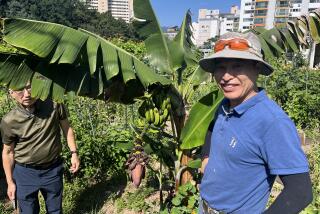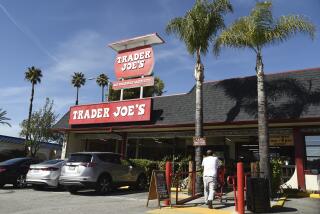The Star of the Show
- Share via
In the kitchen, they’re among the plainest of fruits. You slice them into cereal; when they get too dark, you might make them into bread. But in the produce department, bananas get treatment worthy of a prima donna.
There’s a good reason for that. Bananas typically make up a dominating 10% of the average produce department’s gross sales. As a point of reference, iceberg lettuce contributes only about 2%.
So important are bananas that most grocery chains buy them at set prices on annual contracts. The benefits of such a system became obvious this winter after floods ravaged the east coast of Costa Rica, a country that accounts for roughly 20% of all of Latin American banana exports.
After a storm dumped 28 inches of rain on Costa Rica in a little more than 24 hours, the wholesale price of bananas more than doubled, from about $8 a case to as much as $20. Banana imports are off as much as 15% to 17%.
Prices have settled back down to about $8 to $10 a case in Los Angeles, although experts say the effects of the flooding may linger for five to seven months and prices could go up again.
Because of long-term contracts, the retail price of bananas was’t affected nearly as much as wholesale; the national average went from about 47 cents to a little more than 60 cents a pound, according to figures from the Commerce Department.
But buying and selling are only the start of bananas’ star treatment. In most grocery chains, they also get their own dressing rooms.
“Bananas probably get more special attention and handling than anything else in the department,” says Roger Schroeder, vice president for produce of Hughes Markets. “Not only is it our biggest-selling item, but we also have to bring them in and ripen them, and that takes special attention.”
Most of the bananas in the United States are imported by one of three giant companies--Dole, Del Monte and Chiquita--that represent growers throughout Central and South America. The bananas are shipped either to the Port of Los Angeles in Long Beach or to Port Hueneme, just south of Oxnard.
From there they are trucked to the various chains’ warehouses, where they are ripened in special storage rooms by careful manipulation of temperature and exposure to ethylene gas--the gas given off by apples, for example.
Then, with yellow skin and slightly green tips, they are sent to the grocery stores, ready for their close-ups.
More to Read
Sign up for The Wild
We’ll help you find the best places to hike, bike and run, as well as the perfect silent spots for meditation and yoga.
You may occasionally receive promotional content from the Los Angeles Times.







